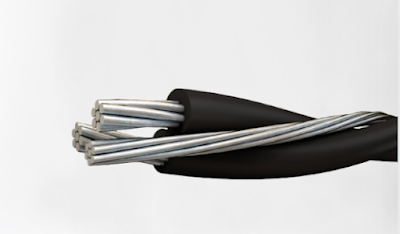What is an Armoured cable and its types
In the electrical industry, safety and durability play a very important role in the whole process.
Armoured cables also play a vital role in transmission of current for different activities like mining.
What exactly is an Armoured Cable?
Armoured cables have an extra layer of protection added to them to increase their durability and safety.
The additional layer is usually metal, but it can also be plastic or fibre. The armour layer protects the cable against physical damage such as impact, crushing, or abrasion as well as environmental hazards such as moisture, chemicals, and extreme temperatures.
Types of Armoured Cable
Steel Wire Cable (SWA)
It has a steel wire armour layer that provides excellent mechanical stress resistance, allowing it to be used in harsh environments. SWA cable is used in underground installations, industrial applications, and outdoor installations.
Aluminum Wire Cable (AWA)
The AWA cable is similar to the SWA cable, but the difference is that it has an aluminium armour layer instead of a steel armour layer. AWA cables are easier to handle and install because they are lighter than SWA cables.
AWA cable is used in power distribution systems, industrial applications, and underground installations.
Steel Tape Cable (STA)
The STA cable has a steel tape armour layer that protects it from mechanical stress and makes it suitable for use in harsh environments.
Power transmission systems, underground installations, and industrial applications all make use of STA cable.
Armored Cable with a Lead Sheath (LSAC)
The LSAC cable has a lead sheath that protects it from moisture and chemicals. The lead sheath also acts as an electromagnetic shield, making it appropriate for use in areas where electromagnetic interference is a concern. Power distribution systems, underground installations, and industrial applications all make use of LSAC cable.
Armored Braided Cable
The braided armoured cable has a braided armour layer that provides mechanical stress protection, making it suitable for use in harsh environments.
The braided armour layer also provides electromagnetic shielding, allowing it to be used in areas where electromagnetic interference is a concern.
Power transmission systems, industrial applications, and underground installations all make use of braided armoured cable.
Armoured cable specifications
Armoured cable is a type of electrical cable that is protected by a metal or plastic sheath, which provides additional mechanical protection against damage, moisture, and other hazards.
The specifications for armoured cables can vary depending on the application, but some common features and characteristics include:
Conductor Size: The size of the conductors (wires) inside the cable is typically specified in terms of their cross-sectional area in square millimetres (mm²) or American Wire Gauge (AWG).
Insulation Material: The insulation material used in armoured cable is typically either PVC or XLPE (cross-linked polyethylene), which provides electrical insulation and protection against moisture and other environmental factors.
Armour Material: The armour of the cable can be made of various materials, including galvanized steel, aluminium, or non-metallic materials like polyethylene. The armour provides additional protection against mechanical damage and external hazards.
Voltage Rating: The voltage rating of the cable specifies the maximum voltage that the cable can safely handle. The voltage rating is determined by the insulation material and the distance between the conductors.
Temperature Rating: The temperature rating of the cable specifies the maximum temperature that the cable can safely operate at without degrading the insulation or other components.
Environmental Rating: The environmental rating of the cable specifies the conditions under which the cable can be safely used, including factors such as moisture, sunlight exposure, and temperature extremes.
Flame Resistance: Armoured cables are often required to meet certain flame resistance standards, which ensure that the cable will not ignite or spread flames in the event of a fire.
Bend Radius: The bend radius of the cable specifies the minimum radius that the cable can be bent without damaging the insulation or other components.
Length: The length of the cable can be specified to meet the needs of the application, and the cable may be supplied in rolls or cut to custom lengths.
Applications and uses of armoured cables
Power distribution
Armoured cables are widely used for power distribution in a variety of industries. The most common type of armoured cable used for power distribution is steel wire armoured cable (SWA).
Industrial application
It is commonly used in industrial applications where they are subjected to harsh environments, extreme temperatures, and mechanical stress. In industrial applications, steel-taped armoured cable (STA) and braided armoured cable (BAC) are commonly used.
Mining activity
Armored cables are used in marine applications where the cables are subjected to harsh seawater environments. SWA cables are frequently used in marine applications.
Military applications
Where the cables are subjected to harsh environments and mechanical stress. Military applications frequently make use of braided armoured cable.
Telecommunications
In telecommunications, armoured cables are used to protect fibre optic and copper cables. Steel-wire armoured cable (SWA) and braided armoured cable (BAC) are both widely used in telecommunications.
Finally, armoured cables are critical for shielding cables against environmental hazards, mechanical stress, and physical damage. The application and level of protection required dictate the type of armoured cable to be used.
Wrapping up
Armoured cables provide an extra layer of security, increasing their durability and safety.
The application, environmental conditions, and required level of protection all influence the type of armoured cable to be used.
The most common types of armoured cables are SWA, AWA, STA, LSAC, and braided armoured cables.
When selecting an armoured cable, it is critical to consider factors such as the cable's voltage rating, current rating, insulation, and conductor material to ensure it meets the specific application requirements. Znergy Cable is one of the Australia's leading armoured cable suppliers and armoured cable manufacturers.




Comments
Post a Comment